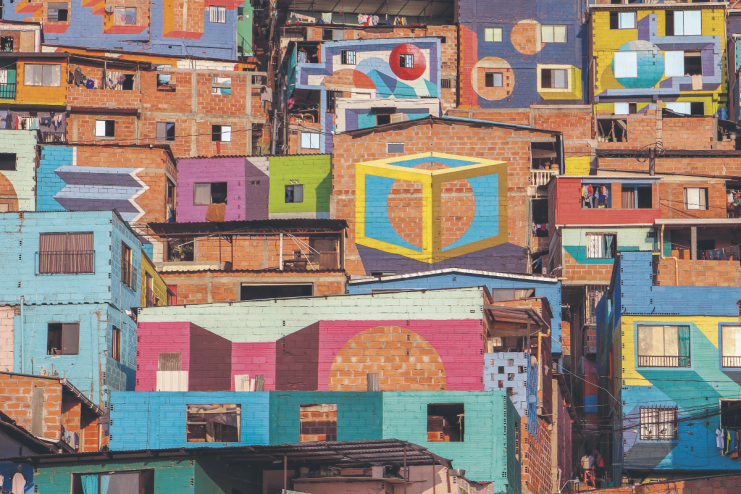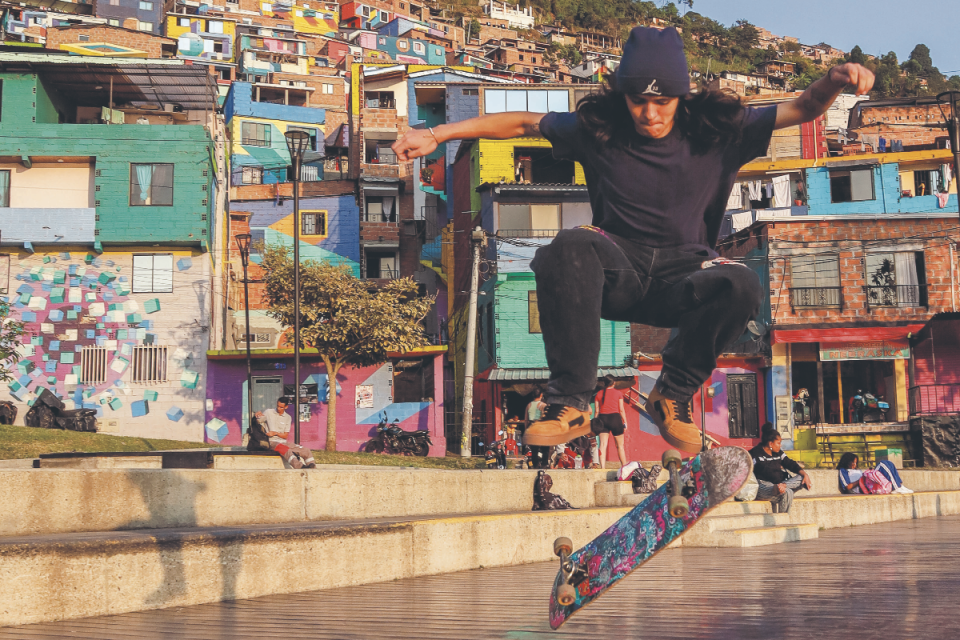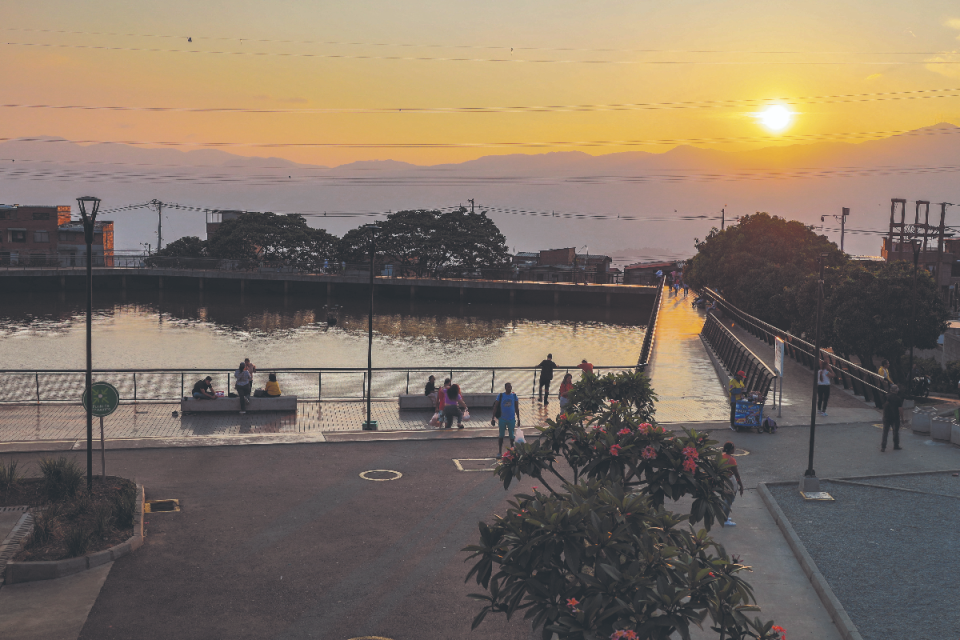
The first English-speaking tourist to visit this once-dangerous Medellin neighbourhood, Adam Bloodworth finds a Colombia with a new sense of purpose. Photography by Omar Portella
Oscar is crouching on an upturned breeze block, resting in the afternoon sun. Behind him, an eight thousand foot drop towards the city of Medellin. On the way down the hill, tree top canopies cluster like ink blots, contrasting with the dense houses. The view stretches hundreds of miles across Colombia. We had trekked uphill in the sweltering heat, climbing outdoor staircases threaded between settlements. Here, the bodies of poisonous snakes lay outside homes with their heads crushed against steps. You wouldn’t chance it this far from a hospital.
Up and up, sometimes at forty-five degree angles, past smiling, matronly women resting with their chickens, each woman’s home boasting an incredible view of the city. Medellin’s trendy rooftop bars, an hour’s drive below, already feel like a fading memory. We turned up a stairwell into Oscar’s kitchenette, where photos of his daughter lined the walls. It was here that four attempts had been taken on his life by gangs, but more on that later. Back out into the light and even further up the mountain, we stopped at a ten-metre-wide slab of poured concrete so perilously high that I backed into the mountainside to feel grounded.
Oscar sat on that upturned breeze block, leant forward with his hands pursed, and began to tell me his story. The social leader of the people of Comuna 3, one of 13 districts in Medellin, he is spearheading a regenerative social movement here with support from the local government, employing street artists and local school children to paint murals.

Welcoming tourists to the formerly dangerous neighbourhood is part of his plan. I was, he believed, the first English speaking tourist to visit. Over the next year Oscar hopes to turn this area of upturned concrete blocks into a small visitor centre and cafe, bringing new life to this working class area of the city, which has a population of over 2.5 million Colombians. “Nothing will stop me doing this work,” he said.
But it’s work that has almost cost Oscar his life. Anyone who helps the poorer areas of Colombia is an enemy to gang leaders. Social justice projects don’t bring in cash so any focus on levelling up is a distraction. Many Colombian districts are still run by gangs despite the image the country tries to present. Oscar puts his neck on the line to bring a new dawn, he says, but assures me I’m safe here with a guide. So do the companies that have begun offering trips to Comuna 3 over the past few months, providing a flavour of the real life of the people of Medellin.
If Margate is Shoreditch-on-Sea then Medellin might be Shoreditch-in-Jungle. In the posh Parque Lleras district, plush rooftop bars with pounding sound systems compete in the height stakes with the rainforest canopies and often get tangled up within them
The street art, some depicting imagined realities of the future, designed by locals, is charming but a visit to Comuna 3 is as much about the surprised looks on the faces of locals who wonder why there are tourists wandering their streets. Locals walk for hours every day to their jobs in the city centre, with transport options often pricing them out.
Comuna 13 is Comuna 3’s celebrity cousin. One of the most dangerous places in the world in the 1980s during Pablo Escobar‘s reign, these days it is Disneyland by comparison, and Colombia’s earliest example of successful urban planning post Escobar. Gentrified for decades, the currency has changed from terror to tourists. Gift shops tout graffiti art tees and knock-off Barbie merchandise. It’s completely mainstream now, but worth visiting to see what twenty years of tourism has done for the area. If every second person meandering through the neighbourhood, with its prize views over the city, is a British tourist, everyone else is a beaming Colombian doing a local dance for cash, offering you food or pouring you a glass of aguapanela, a sugar cane drink to enjoy while you take in the view.

Later, I was doing laps of the rooftop pool at the Marquee Medellin hotel to blow off steam after what had been an eye-opening day. If Margate is Shoreditch-on-Sea then Medellin might be Shoreditch-in-Jungle. It’s an incredibly cool and architecturally rich city, its nouveau hotels sprouting from the thick swathes of jungle. In the posher Parque Lleras district, plush rooftop bars with pounding sound systems compete in the height stakes with the rainforest canopies and often get tangled up within them. An evening’s walk has you criss- crossing over flumes of water running off the mountains and through copses of triple- height bamboo – it feels remote and jungly one minute, then a few steps later you’re back in the 21st century, turning a corner and being confronted by someone trying to flog you a plastic model of Pablo Escobar.
Stubborn Mule can help you find where to go in Colombia, from gritty street art tours to the depths of the jungle and the beach
Go out in groups and stay with other people. In Parque Lleras, queer venues back onto Latino dance halls and late-night bars serving punchy margaritas. Walking through the city-then-jungle passageways gives proper Honey I Shrunk The Kids vibes. I booked paragliding via family travel specialists Stubborn Mule Travel to see the full scope of the changing city, and Green Travel organises a city centre tour including a visit to the Medellín River, which is being pedestrianised, giving you a fascinating glimpse at where corporate types wander on their lunch breaks. The Botero Plaza, with its bulbous, cumbersome sculptures by Colombian artist Fernando Botero, are unwieldy and magnificent, although their recent placement behind protective barriers to avoid homeless people gathering near them is in direct contradiction with the artist’s wishes for the pieces to be for everyone. It couldn’t be a clearer sign of Colombia’s fraught relationship with its own people.
An overcast afternoon in Bogota and Camilo is practising his BMX moves in the Ciudad Bolívar skate park high above the city. Cable cars were introduced from the Colombian capital to this suburban district in 2018, connecting what was a historically cut off and impoverished part of the capital to its wealthier heart. Local projects similar to Oscar’s in Medellin mean the streets are lined with art, welcoming tourists who want to get closer to the ‘real’ Bogota and support the city’s people.
Skater Camilo isn’t interested in that. He’s practising ollies and has grown tired of the huge city view that forms the backdrop to the skate park. How long before you start to take these views for granted? My tour with Impulse Travel, booked through the Latin Routes company, took me past groups of locals perched on walls by playing fields, into alternative bric-a-brac shops selling old Colombian records and vintage board games, and into cafes with local beef empanadas and fridges filled to the brim with Aguila beer. Two pastry parcels and a beer was roughly a pound. Locals cannot afford the cable cars, so the reality is that many still walk for hours into the capital, like they do from Comuna 3, but at least the leaders of these tours empower locals with opportunities and drive the economy.
Bogota is a frenetic and sprawling city, but Colombian Journeys helped me carve out an itinerary. I was staying at the Hotel Coco, with a fab rooftop restaurant for breakfast, offering views of the undulating mountains and colourful districts. A half day Egipto Neighbourhood Experience organised by Colombian Journeys got me even closer to the country’s terrible, bloody history: men formerly tied up with gangs sold us carvings; women the clothes they tailor in a newly-built factory paid for by tourism. One man had been in prison for something awful but seemed incredibly proud of the ornaments he was flogging us, evidenced by the wide smile on his face. Here, you really can get closer to Colombia than ever before.
Visit Colombia yourself
Colombian Journeys can help you plan your Colombian trip, whether you’re wanting to see ocean, city, jungle or a bit of everything. Stubborn Mule Travel is a family holiday specialist with a focus on off-the-beaten path destinations. They can arrange Colombia trips taking in remote mountain villages, hikes, wildlife spotting and uncovered elements of the cities. Avianca fly direct from London Heathrow to Bogota from around £660.

